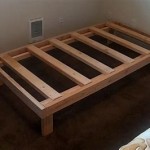What Thickness Plywood For Platform Bed?
Platform beds combine style and comfort, making them a popular choice for bedrooms of all sizes. Constructing a platform bed requires careful attention to the materials used, particularly the plywood. The thickness of the plywood is crucial in determining the bed's stability, durability, and overall quality.
Selecting the appropriate plywood thickness for a platform bed is essential. Plywood comes in various thicknesses, ranging from 1/4 inch to 3/4 inch. While thicker plywood may seem like an obvious choice for a sturdy bed, it's vital to strike a balance between strength and practicality.
1/2 Inch Plywood: A Versatile Choice
For most platform bed builds, 1/2-inch plywood proves to be the ideal thickness. It provides a solid balance of strength, affordability, and ease of use. Here are several reasons why 1/2-inch plywood is a preferred choice:
1. Strength and Support: 1/2-inch plywood offers sufficient strength to support the weight of a mattress and sleeper. It can withstand everyday use without bending or sagging, ensuring a comfortable and stable sleeping experience.
2. Affordability: Compared to thicker plywood options, 1/2-inch plywood is more economical. It offers good value for money while still delivering the necessary durability for a platform bed.
3. Workability: 1/2-inch plywood is easy to cut, drill, and assemble. It can be manipulated with standard tools and doesn't require specialized equipment. This makes it an excellent choice for DIY enthusiasts and those looking for a straightforward building process.
4. Variety of Options: 1/2-inch plywood comes in various grades and species, allowing you to select the plywood that best suits your needs and budget. You can choose from plywood with different levels of moisture resistance, durability, and aesthetic appeal.
When 3/4-Inch Plywood Is a Better Choice
In certain situations, opting for 3/4-inch plywood for a platform bed may be beneficial. Consider the following scenarios:
1. Extra Heavy-Duty: If you plan on constructing a platform bed intended for heavy-duty use, such as one designed for multiple sleepers or excessive movement, 3/4-inch plywood can provide additional strength and rigidity.
2. Increased Durability: In areas with high humidity or moisture levels, 3/4-inch plywood is a better choice due to its enhanced moisture resistance, reducing the risk of warping or damage.
3. Custom Builds: If you're creating a custom platform bed with unique design elements or intricate joinery, the increased thickness of 3/4-inch plywood may be necessary to accommodate these features.
Conclusion
Selecting the appropriate plywood thickness for a platform bed is essential for achieving a sturdy, durable, and comfortable sleeping solution. While 1/2-inch plywood is often the ideal choice due to its balance of strength, affordability, and ease of use, 3/4-inch plywood may be preferred in cases where extra heavy-duty construction, increased durability, or custom design elements are required. Ultimately, the choice depends on your specific needs, preferences, and budget.

How To Choose Plywood For Bed Frames

How To Choose Plywood For Bed Frames
How To Choose The Best Plywood For A Bed Quora

Diy Plywood Bed Modern Builds
How Thick Should The Plywood Base For This Bed Be Woodworking Talk
Diy Plywood Bed Modern Builds

Diy Plywood Bed Modern Builds

Diy Platform Bed In Just 3 Steps Vintage Revivals

Easy Diy Twin Platform Bed Frame Tutorial Domestic

Bed Slats Vs Plywood Which Is Best For Your Frame







